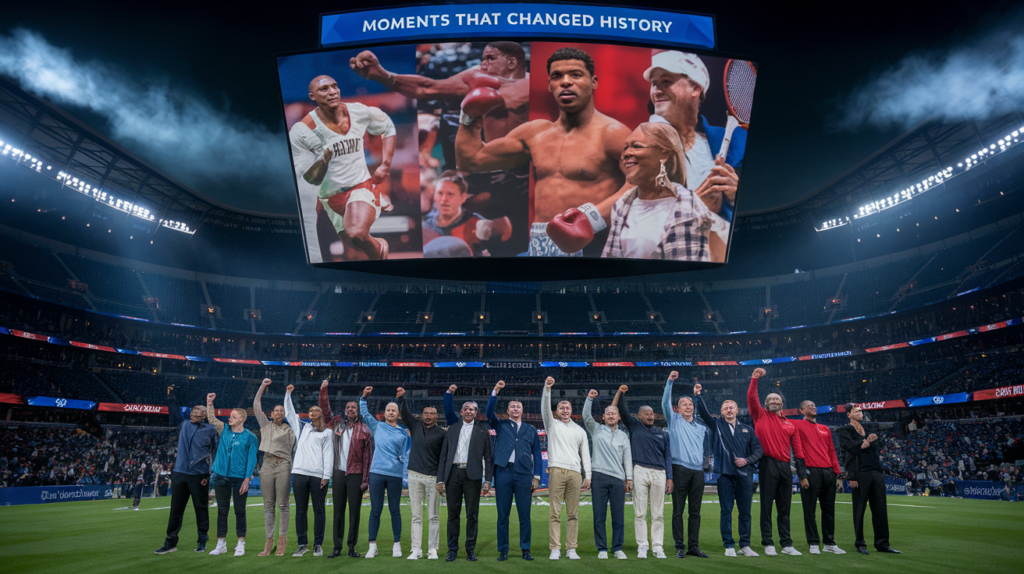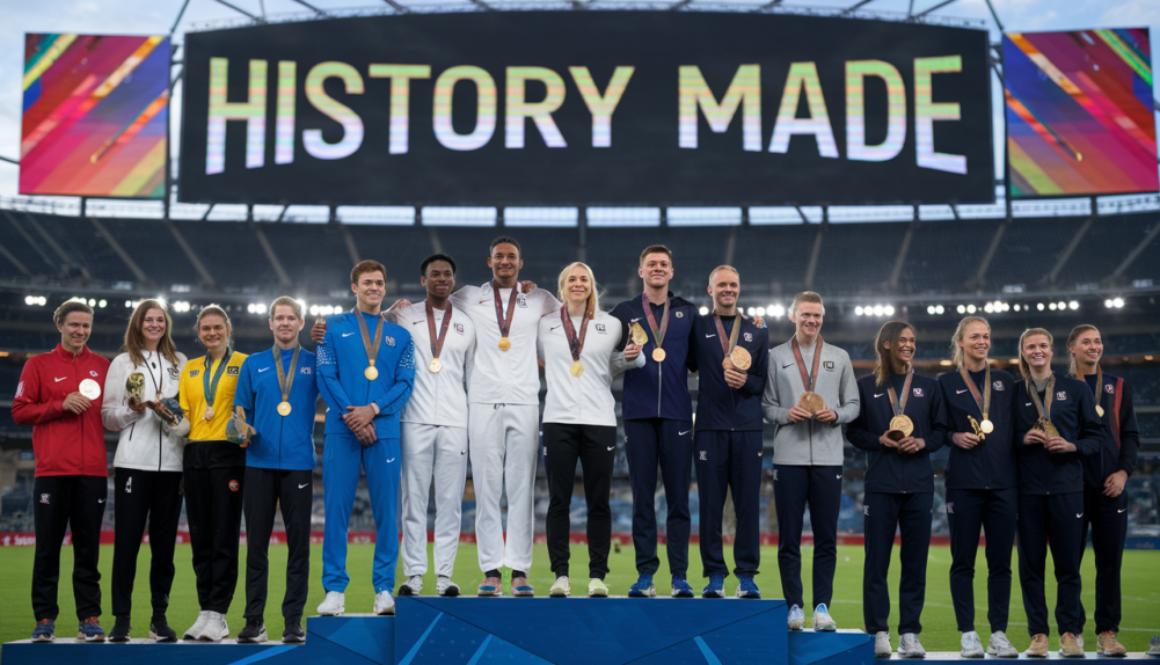10 Unforgettable Sports Moments That Changed History

In the vast arena of human achievement, few spectacles capture our collective imagination quite like sports. But what happens when athletic prowess collides with historical significance? 🏆🌟 The result is nothing short of extraordinary – moments that don’t just change the scoreboard, but alter the course of history itself.
From defiant gestures that challenge societal norms to miraculous victories that defy all odds, sports have given us some of the most unforgettable moments in human history. These aren’t just games; they’re milestones that have shaped our world, broken barriers, and inspired generations. Get ready to relive 10 Unforgettable Sports Moments That Changed History – stories of triumph, courage, and the indomitable human spirit that will leave you awestruck and inspired. 💪🌍
As we dive into these legendary moments, from the ice rinks of Lake Placid to the hallowed grounds of Wimbledon, prepare to witness how a single play, a bold stance, or a groundbreaking achievement can echo through time, forever changing the landscape of both sports and society. Let’s embark on this thrilling journey through history, where athletes became icons, underdogs became heroes, and the world watched in amazement.
The Miracle on Ice: USA’s Triumph Over Soviet Union

Cold War tensions in sports
The Miracle on Ice unfolded against the backdrop of intense Cold War rivalries, where sports became a proxy battlefield for ideological supremacy. During this era, athletic competitions between the United States and the Soviet Union were charged with political significance, often serving as a measure of national strength and pride.
| Aspect | United States | Soviet Union |
|---|---|---|
| Sports System | Largely amateur | State-sponsored |
| Olympic Success | Varied | Dominant in many sports |
| Political Ideology | Capitalism | Communism |
| Public Perception | Underdog | Powerhouse |
The underdog story of the U.S. team
The 1980 U.S. Olympic hockey team epitomized the classic underdog narrative:
- Youngest team in U.S. Olympic history
- Composed primarily of amateur and collegiate players
- Faced a Soviet team with years of international experience
- Overcame a 10-3 loss to the Soviets in an exhibition game just days before the Olympics
Impact on American morale and patriotism
The victory over the Soviet Union transcended sports, becoming a symbol of American resilience and hope:
- Boosted national pride during a period of economic and political challenges
- Reignited patriotic fervor across the country
- Provided a unifying moment for Americans of all backgrounds
- Inspired the famous call: “Do you believe in miracles? Yes!”
- Remains an enduring symbol of American determination and spirit
This historic win not only changed the landscape of international hockey but also left an indelible mark on American culture, demonstrating the power of sports to influence national morale and international relations. As we explore the next transformative moment in sports history, we’ll see how athletic achievements continued to shape societal perceptions and challenge existing norms.
Jesse Owens Defies Hitler at the 1936 Olympics

The political climate of Nazi Germany
In the years leading up to the 1936 Olympics, Nazi Germany was a hotbed of racial tension and political upheaval. Adolf Hitler’s regime had implemented a series of discriminatory laws and policies aimed at promoting their ideology of Aryan supremacy. This created a hostile environment for athletes of color, particularly those from other nations.
| Nazi Germany’s Policies | Impact on Sports |
|---|---|
| Racial segregation | Limited opportunities for non-Aryan athletes |
| Anti-Semitic laws | Jewish athletes excluded from competitions |
| Propaganda campaigns | Promotion of Aryan athletic superiority |
Owens’ record-breaking performances
Despite the oppressive atmosphere, Jesse Owens dominated the 1936 Berlin Olympics with a series of remarkable achievements:
- Won four gold medals in track and field events
- Set three world records and tied another
- Became the most successful athlete of the Games
His incredible performances included:
- 100-meter sprint: 10.3 seconds (Olympic record)
- Long jump: 8.06 meters (Olympic record)
- 200-meter sprint: 20.7 seconds (World record)
- 4×100-meter relay: 39.8 seconds (World record)
Challenging racial stereotypes on a global stage
Owens’ triumph at the 1936 Olympics was more than just a sporting achievement; it was a powerful statement against racial prejudice. His success directly contradicted Hitler’s claims of Aryan superiority and showcased the talent and potential of African American athletes. This moment in sports history became a catalyst for challenging racial stereotypes worldwide, inspiring future generations of athletes and activists.
Muhammad Ali’s Stand Against the Vietnam War

Ali’s refusal to be drafted
Muhammad Ali’s bold decision to refuse the draft for the Vietnam War in 1967 sent shockwaves through the sports world and beyond. Citing religious beliefs and opposition to the war, Ali famously declared, “I ain’t got no quarrel with them Viet Cong.” This stance was not only a personal conviction but also a powerful statement against racial injustice and the disproportionate impact of the draft on African Americans.
Consequences for his boxing career
Ali’s principled stand came at a tremendous cost to his career:
- Stripped of his heavyweight title
- Boxing license revoked
- Banned from competing for 3.5 years
- Faced potential imprisonment
Despite these setbacks, Ali remained resolute in his beliefs, sacrificing his prime years as an athlete for his principles.
Influence on the civil rights movement
Ali’s actions resonated far beyond the boxing ring, galvanizing the civil rights movement:
| Impact Area | Description |
|---|---|
| Inspiration | Encouraged other athletes to speak out on social issues |
| Visibility | Brought antiwar sentiment to mainstream attention |
| Unity | Rallied support from diverse groups, including students and activists |
His stance against the war became a rallying point for civil rights activists, antiwar protesters, and those fighting for social justice. Ali’s eloquence and charisma in defending his position made him a powerful voice for change, inspiring generations of athletes to use their platforms for social activism.
The Black Power Salute at the 1968 Olympics

Tommie Smith and John Carlos’ silent protest
Tommie Smith and John Carlos made history at the 1968 Olympics with their iconic Black Power salute. During the medal ceremony, they raised gloved fists, symbolizing Black unity and protest against racial injustice. This powerful gesture became a defining moment in sports and civil rights history.
Global reaction and controversy
The protest sparked immediate controversy:
- IOC: Condemned the action
- US Olympic Committee: Expelled Smith and Carlos
- Media: Mixed reactions worldwide
- Public: Divided opinions
| Supporters | Critics |
|---|---|
| Civil rights activists | Sports traditionalists |
| Fellow athletes | Government officials |
| Some media outlets | Conservative public |
Billie Jean King Battles Bobby Riggs in the “Battle of the Sexes”

A. The challenge and build-up to the match
Bobby Riggs, a former tennis champion, challenged Billie Jean King to a highly publicized match in 1973. The event, dubbed the “Battle of the Sexes,” garnered immense media attention and sparked debates about gender equality in sports.
| Key Points | Details |
|---|---|
| Date | September 20, 1973 |
| Venue | Houston Astrodome |
| Prize Money | $100,000 |
| TV Audience | 90 million worldwide |
B. King’s victory and its significance
King’s resounding victory over Riggs in straight sets (6-4, 6-3, 6-3) became a watershed moment for women’s sports. Her win not only silenced critics but also:
- Inspired a generation of female athletes
- Challenged gender stereotypes in sports
- Boosted the women’s liberation movement
Diego Maradona’s “Hand of God” Goal

A. The controversial goal against England
In the 1986 World Cup quarter-final, Diego Maradona scored a controversial goal against England using his hand. This incident, dubbed the “Hand of God,” sparked intense debate about fair play and officiating in football. The goal was allowed to stand, despite clear video evidence of the handball.
| Aspect | Details |
|---|---|
| Match | Argentina vs England, 1986 World Cup |
| Score | Argentina won 2-1 |
| Controversy | Maradona’s handball goal |
| Aftermath | Ongoing debates about technology in football |
B. Argentina’s World Cup victory
Magic Johnson’s HIV Announcement

Shock waves through the sports world
Magic Johnson’s HIV announcement in 1991 sent shockwaves through the sports world. The revelation challenged misconceptions about HIV/AIDS and sparked crucial conversations.
| Impact | Description |
|---|---|
| Sports | Forced NBA to address HIV policies |
| Society | Raised awareness about HIV transmission |
| Media | Increased coverage of HIV/AIDS issues |
Raising awareness about HIV/AIDS
Johnson’s disclosure significantly elevated public awareness about HIV/AIDS. His high-profile status helped:
- Reduce stigma surrounding the disease
- Encourage HIV testing and prevention
- Promote education about transmission and treatment
Jackie Robinson Breaks the Color Barrier in MLB

The significance of Robinson’s debut with the Brooklyn Dodgers
Jackie Robinson’s debut with the Brooklyn Dodgers in 1947 marked a watershed moment in sports history. As the first African American to play in Major League Baseball, Robinson shattered the color barrier and paved the way for integration in America’s pastime.
Challenges faced on and off the field
| Challenges | On the Field | Off the Field |
|---|---|---|
| Racism | Verbal abuse | Death threats |
| Segregation | Separate facilities | Limited accommodations |
| Pressure | High expectations | Media scrutiny |
Robinson faced enormous obstacles, including:
- Racial slurs from opponents and fans
- Discrimination in hotels and restaurants
- Intense pressure to perform and maintain composure
The Comeback of Tiger Woods
Woods’ fall from grace and injuries
Tiger Woods’ career took a dramatic turn in 2009 with personal scandals and injuries. His golf performance declined, and he struggled with back problems, undergoing multiple surgeries. This period saw Woods drop from world No. 1 to outside the top 1,000, leading many to believe his career was over.
His unexpected 2019 Masters victory
| Year | Tournament | Result |
|---|---|---|
| 2019 | Masters | Winner |
Woods’ 2019 Masters win was a stunning comeback. After an 11-year major drought, he clinched his 15th major title, showcasing:
- Mental resilience
- Physical recovery
- Unwavering skill
This victory reignited his career and inspired millions worldwide.
The “Miracle at the Meadowlands”
A. The Eagles-Giants game that changed NFL strategy
The “Miracle at the Meadowlands” in 1978 revolutionized NFL strategy. With seconds remaining, Giants quarterback Joe Pisarcik fumbled a handoff, allowing Eagles cornerback Herman Edwards to score a game-winning touchdown. This shocking play led to the widespread adoption of the “victory formation” in end-game scenarios.
| Before | After |
|---|---|
| Risky plays | Victory formation |
| No kneeling | Kneeling to run out clock |
B. Impact on clock management and victory formation
- Teams prioritized ball security in final moments
- Coaches emphasized smart decision-making
- Victory formation became standard practice
- Enhanced focus on clock management strategies

Sports have the power to transcend boundaries, challenge societal norms, and inspire generations. The ten moments highlighted in this blog post showcase the incredible impact athletes can have both on and off the field. From Jesse Owens’ defiance of Hitler’s racist ideology to Magic Johnson’s brave HIV announcement, these events not only changed the course of sports history but also influenced broader social and cultural movements.
These unforgettable moments remind us that sports are more than just games. They are a reflection of our society, a platform for change, and a source of hope and inspiration. Whether it’s Jackie Robinson breaking the color barrier in baseball or Billie Jean King’s fight for gender equality, athletes have consistently used their platforms to push for progress and challenge the status quo. As we look to the future, let us remember the power of sports to unite, inspire, and create positive change in our world.


